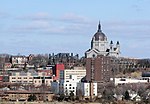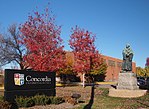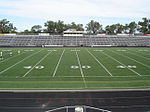Ayd Mill Road
Chicago, Milwaukee, St. Paul and Pacific RailroadStreets in Saint Paul, Minnesota

Ayd Mill Road is a road in Saint Paul, Minnesota. It runs diagonally through Saint Paul, connecting with Interstate 35E at its southeast terminus, and feeds into Selby Avenue at its northwest end. Indirect access to I-94 is possible via Selby and Snelling Avenues. Originally known as the Short Line Road, it was renamed in 1987 for John Ayd, a German settler who maintained a mill and residence in the area in the mid-to-late 19th century.
Excerpt from the Wikipedia article Ayd Mill Road (License: CC BY-SA 3.0, Authors, Images).Ayd Mill Road
Ayd Mill Road Trail, Saint Paul Summit Hill
Geographical coordinates (GPS) Address Nearby Places Show on map
Geographical coordinates (GPS)
| Latitude | Longitude |
|---|---|
| N 44.94 ° | E -93.152222222222 ° |
Address
Ayd Mill Road Trail 50
55105 Saint Paul, Summit Hill
Minnesota, United States
Open on Google Maps









